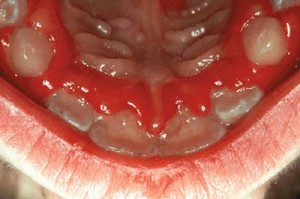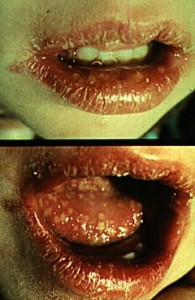Gingivostomatitis is a common oral condition that affects many children across the world. Read on to know all about the causes, symptoms, diagnosis and treatment of this syndrome.
What is Gingivostomatitis?
Page Contents

Picture 1 – Gingivostomatitis
Source – mchoralhealth
It is a type of bacterial or viral infection that affects the gums and the mouth of a person thereby leading to inflammation and the development of sores.
The name of this disease is a combination of stomatitis and gingivitis, two separate disorders.
Gingivostomatitis Causes
This infection is typically caused after an attack of the physical system by HSV-1 (Herpes Simplex Virus Type 1) which also gives rise to cold sores. A Coxsackie virus infection may also lead to this disorder. People with poor oral hygiene are also susceptible to this condition.
Herpetic Gingivostomatitis
It is an infection caused by Herpes Simplex Virus Type One (HSV-1). This is usually transmitted from individuals infected with the virus to healthy individuals through contact with saliva. The condition is characterized by a series of lesions in the mouth. Primary Herpetic Gingivostomatitis or Primary Herpes Gingivostomatitis is marked by restlessness, fever and inflammation of the gums. Acute Herpetic Gingivostomatitis or Severe Herpes Simplex Gingivostomatitis is characterized by bleeding from the gums, irritability and inflamed lymph nodes in the mouth.
HSV Gingivostomatitis is cured with the aid of antiviral drugs and supportive care. The patient is administered fluids at regular intervals to ensure hydration.
Gingivostomatitis in Children
This is a very common condition in children. Gingivostomatitis in toddlers and elder children is typically a result of poor oral hygiene. Primary Herpes Gingivostomatitis in children is marked by crying, irritable mood and restlessness. Acute Herpes Gingivostomatitis can lead to drooling, fever and lymph node inflammation. Antiviral and anti-inflammatory drugs are used to check this condition in children. Proper oral hygiene should be maintained to get rid of this disease and also prevent its recurrence.
Gingivostomatitis Diagnosis
The condition is generally diagnosed by a simple examination of the mouth of the suffering person. Special oral tests are usually not required for diagnosis. In some cases however, a small amount of tissue may be removed from the mouth for microscopic inspection in a laboratory. This tissue culture helps in detecting presence of bacteria or virus in the tissues and confirms diagnosis.
A tiny amount of skin may also be taken from the mouth for biopsy. Biopsy helps in ruling out presence of other conditions that might be responsible for symptoms similar to Gingivostomatitis. Skin biopsy becomes necessary if the health care provider finds other symptoms such as muscle pain or cough.
Gingivostomatitis Symptoms
Some of the main symptoms of Gingivostomatitis are :
Inflammation
Swelling of the mouth is one of the major symptoms of this condition. The face of a suffering individual is often seen to have a bloated appearance due to inflammation.
Oral sores
Patients of this disease also suffer from painful sores on the inner part of their gums and cheek. Sufferers find it difficult to eat food due to these sores.
Fever
Inflammation and oral sores are often accompanied by a rise in body temperature. Fever is a cause of great discomfort and may impair normal functioning of the suffering person.
Bad breath
Patients also suffer from a bad breath in their mouth. The intensity may be mild or severe and may vary from person to person.
There is also a general feeling of discomfort and uneasiness in sufferers of this condition. Malaise or ill feeling is common in most sufferers.
Gingivostomatitis Treatment
The aim of treatment for Gingivostomatitis is to provide relief from the discomforting symptoms arising from this condition. Antibiotics may be required in some cases. Analgesics or pain relievers such as Ibuprofen and Acetaminophen may also be used to reduce ache. If it hurts a lot while eating, your doctor may prescribe a strong pain reliving medicine.
In some cases, a process called Debridement may be carried out for Gingivostomatitis cure. The method involves cleaning the infected tissue from the mouth. Mouth wash medications may also be prescribed to provide relief from painful symptoms. Over the counter mouthwash medicines like Xylocaine or Hydrogen Peroxide may provide a soothing sensation to sufferers.
Gingivostomatitis Home Remedy
In treatment of Gingivostomatitis home remedies are necessary to be used along with medications. Some of the main Gingivostomatitis natural remedies are
Proper diet
Have a well balanced diet that involves all essential minerals and nutrients. Include foods rich in Vitamin C such as tomatoes and cranberries into your diet to improve your immunity. A strong immune system will help you get rid of discomforting conditions like Gingivostomatitis.
Salt water wash
Mix half teaspoon salt with one cup of water. Wash your mouth with this solution for two to three times daily to destroy the microbes and improve your oral sores.
Avoid spicy foods
Foods that are rich in spice can irritate the oral sores and cause more pain and discomfort. This can make you unable to eat properly. Eat foods that are non-spicy such as yogurt, ice cream and applesauce. You should also try to avoid solid foods as much as possible as you may find these very difficult to eat. Try to settle for snow cones and mashed potatoes instead. These foods, though solid, are easier to eat.
Avoid dehydration
Keep yourself hydrated with soothing drinks like juice, water and milk. Try to avoid hot drinks like tea or coffee which can irritate your mouth sores.
Gingivostomatitis Prognosis
The symptoms of this condition may range from mild to severe depending on the acuteness of the infection. The oral sores generally resolve in two to three weeks even without treatment. However, treatment can ease the painful symptoms and speed up recovery for the suffering person.
Gingivostomatitis Complications
This condition does not directly lead to any complicated disorders. In some cases however, they can be a sign for more serious oral ulcers.
Gingivostomatitis Pictures
Want to know how this condition looks like? Go through these useful Gingivostomatitis photos. These pictures of Gingivostomatitis will give you a visual idea about the appearance of the condition.

Picture 2 – Gingivostomatitis Image
Source – neton-line

Picture 3 – Gingivostomatitis Photo
Source – intelligentdental
If there is Gingivostomatitis in adults or children in your home, try home remedies for some days. If you find fever and other complicated symptoms arising along with oral ulcers, it is necessary to seek immediate medical treatment. Cure is also important if the oral sores do not show any improvement even after treatment for 2-3 weeks. Early diagnosis and cure will ensure an early recovery for the sufferer and avoid prolonged discomfort.
References:
http://en.wikipedia.org/wiki/Gingivostomatitis
http://www.nlm.nih.gov/medlineplus/ency/article/001052.htm
http://www.wisegeek.com/what-is-herpetic-gingivostomatitis.htm
http://www.babycenter.com/0_gingivostomatitis_1201460.bc
